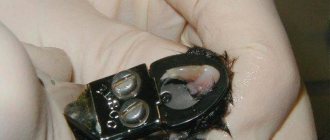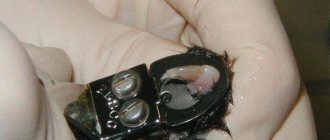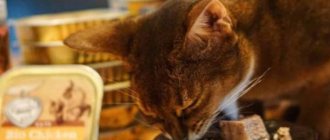Clinical picture of poisoning Therapy
Lilies are very popular and beautiful flowers, often found in homes and used as decorative decorations at many holidays. However, lilies of the genus Lilium and Hemerocallis have been shown to be capable of causing severe nephrotoxicity in cats when ingested. Those. substances contained in flower petals are toxic to kidney tissue. In order to be poisoned by lilies, a cat must eat them.
However, there is a certain amount of confusion about which flowers actually have a poisonous effect. After all, a lot of plants are called lilies. For example, flowers belonging to the genus Convallaria (lily of the valley), which are often confused with lilies, actually do not have a toxic effect on kidney tissue, but can seriously affect cardiac function (by analogy with cardiac glycosides, the drug digitalis). It is also worth remembering that there are many lily hybrids, the effect of which can be quite unpredictable.
Most owners are unaware that lilies can be potentially dangerous to their pets, but cats are extremely sensitive to the toxic effects of these flowers. It should be noted that the entire flower (petals, stamens, pistils) is poisonous to cats.
The exact dose and which toxins have a poisonous effect have not yet been precisely clarified, but, according to clinical observations, a very small part of the flower can provoke a severe attack (for example, a couple of petals).
The rapid onset of an attack indicates that toxins are absorbed very quickly. The kidney tubules are the first to be damaged.
Nephrotoxicity of lily for cats
There are many different types of plants called "lilies": Easter lily, lily lily, Asiatic lily, tiger lily, peace lily, calla lily and lily of the valley, among others.
And while they may be beautiful to look at, a cat can die from kidney failure if it eats any part of these toxic species and does not receive immediate treatment.
In fact, just two leaves can make your cat sick and, if left untreated, can become fatal in just three days.
Dangerous types of lilies
It is important to know that many plants have the word "lily" in their name, and they have varying toxic effects on cats. The most dangerous are:
- Hemerocallis species (Daylily, or Red Daylily)
- Lilium x asiatica (Asiatic lily)
- Lilium x asiatica americana
- Lilium candidum (Snow white lily, or pure white lily, or white lily)
- Lilium hydridum (Hybrid lily)
- Lilium lancifolium (Lilium tigrinum)
- Lilium longiforum (Lily Longiflorum)
- Lilium orientalis (oriental lily hybrids)
- Lilium regale (Regal lily, or royal lily, or Tibetan lily, or regale lily, or Chinese lily)
- Lilium speciosum (Lily beautiful, or beautiful lily)
- Lilium rubrum (Lily Rubrum)
- Lilium umbellatum
These types of lilies cause kidney damage in cats. All parts of the plant are toxic, and even a small amount of the plant, sap, or pollen can have serious consequences. Also dangerous is pollen that gets on the cat's fur and the water in which the flowers stand.
The main reason
When determining the toxicity of a lily you want or have, always look at the plant's scientific name. The scientific name consists of two parts: the “name” with a capital letter is the genus; “second name” is a species, it is not capitalized.
You may see additional names after the first and second; these are subdivisions of the species and are not important for determining toxicity. The second name is sometimes abbreviated sp. or species This means that the actual species has not been identified.
Sometimes the name is shortened, usually using only the first letter of the name. This is usually done when there is a list of several species of the same genus.
Of greatest concern are lilies in the genus Lilium (Lilium sp.), which includes Easter lilies, tiger lilies, and Asiatic lilies, as well as any of the genus Hemerocallis (Hemerocallis sp.), including lily lilies.
Cat treatment
Intoxication of the body and liver damage occurs within 1.5-3 days. Considering that a cat’s metabolism is very fast, the first signs appear within a few hours, but a pet can feel ill within an hour and a half. And if you don’t start cleaning your cat on time, the animal may die. Doctors at VK VetDoctor recommend that at the first symptoms of poisoning, especially if it is not possible to immediately take the animal to the clinic, take the following measures:
- Perform gastric lavage. This procedure is carried out using a syringe, removing the needle from it, and introducing about 20 ml of water into the cat’s oral cavity. After this, pressure is applied to the root of the tongue, which causes vomiting.
- It is advisable to give the cat a solution: 0.5 tablets of activated carbon + 5 ml of water to bind the toxic substances. Also administered using a syringe without a needle. If there is Enterosgel in the house, it is given to an animal weighing up to 4 kg, 2.5 g twice a day. “Smecta” is also suitable for this purpose - dilute 0.5 sachets with water, you need 50 ml of it, pour it down the throat at a time.
- To prevent dehydration, the cat is forced to drink at intervals of 15 minutes, pouring about 5 ml of water into the mouth.
If the animal is in a veterinary clinic, then all the necessary medications are administered intravenously.
In a clinical setting, the animal is given an antidote, antibiotics and vitamins intravenously to support the body. If anuria occurs - the inability to urinate due to acute renal failure, the cat undergoes a peritoneal dialysis session. However, the forecasts are not always favorable. Contacting a veterinarian as soon as possible and at the first alarming symptoms will help owners save their pet.
Treatment of cat poisoning with lilies
If your cat has only recently ingested plant material and has not yet vomited, your veterinarian will try to induce vomiting.
Activated charcoal will be administered orally to absorb any toxin that may remain in the intestines. The key to survival is to give plenty of intravenous (IV) fluids to try to prevent dehydration and kidney shutdown.
Fluids will be given for 1-2 days while monitoring your cat's kidney health as well as urine output. Lack of urine is a sign that treatment has failed.
Symptoms of poisoning
Cats by nature are both suspicious and curious. It is unknown why they are attracted to flowers and what prompts them to taste the petals, apparently they love to try everything. In order for toxins to enter the cat's body, it is necessary to eat the source of the poison - lily petals. They can cause a strong nephrotoxic effect in an animal if it enters the gastrointestinal tract.
Organ damage can also be caused by pollen particles in the stamens of a flower and the smell of lilies.
Symptomatic signs of intoxication if a cat has eaten a lily:
- foaming from the mouth;
- nausea and vomiting;
- depression;
- refusal of food;
- increased salivation;
- frequent urination;
- dehydration with increased desire to drink;
- lack of coordination;
- frequent seizures.
Poisonous garden plants
Tulips and hyacinths. The most toxic to animals are the bulbs of these plants. The alkaloids contained in them cause poisoning, which is accompanied by salivation, vomiting, and diarrhea. Therefore, you definitely need to know how to treat diarrhea.
Oleander. A beautiful shrub with evergreen leaves and delicate flowers. Causes vomiting, diarrhea, slows heart rate.
Crocuses. Plants that cause vomiting, diarrhea, gastrointestinal bleeding, kidney and heart problems.
White acacia. Poisoning by acacia leaves is manifested by vomiting, diarrhea, convulsive spasms, and abdominal pain. Possible disturbances in the functioning of the heart, liver and kidneys.
Calendula (marigold). Vomiting may occur if parts of the plant are eaten.
Daisies. A plant with low toxicity. If large amounts are eaten, loss of appetite, vomiting and diarrhea may occur.
Iris. Causes vomiting, diarrhea, stomach cramps, depression.
Clematis. Poisoning is manifested by gastrointestinal disorders: diarrhea, vomiting, refusal to eat.
Rhubarb. The leaves of the plant contain oxalates. Has a systemic toxic effect.
Garden rhododendron (rose tree). Possible heart rhythm disturbances. Intoxication of the body.
Evergreen boxwood (buxus). The decorative evergreen shrub causes severe intoxication in cats. Possible death.
Physalis. Causes convulsions and gastrointestinal upset.
Pansy (viola).
Also poisonous in garden plots are:
- hawthorn;
- wisteria;
- ivy;
- barberry;
- oregano;
- poppy;
- tobacco;
- dogwood.
How to decorate window sills?
First of all, you should pay attention to plants that repel cats. The list is small, but there is plenty to choose from: ponderosa, sheddock, calamondin, kincan, lemongrass, tangerine. Cats hate the smell of citrus fruits, so even if they are seduced by juicy greens, they will not swallow the fragrant leaf. Coleus canine is a modest flower that repels all animals with its pungent odor. It is a garden perennial, but coleus can also be grown in pots.
Guess what plants cats of all breeds and ages do not like? That's right, cacti! These evil thorns will quickly “wean” your pet from tasting indoor greens. Don't be afraid for the cat - they are smart and careful, they don't pick up needles with their paws. You just need to choose really prickly species - a cat can cope with soft tiny thorns in no time. It is better to plant cacti in groups, in wide, stable bowls (small pots will end up on the floor after the first “attack” on the cat).
The following indoor plants, safe for cats, are very popular and do not require care: arrowroot, begonia, chlorophytum, camellia, indoor coleus. Conditionally safe are dracaenas (except for the bordered one) and Saintpaulia (indoor violet).
Therapy and prevention
First, the veterinarian performs detoxification. He gives the cat a drug that binds to toxic components in the body and removes them. If such therapy is carried out within the first 24 hours after poisoning, it can protect the animal from kidney damage. If complications cannot be avoided, the veterinarian performs dialysis. The owner needs to leave the cat in the clinic for about 7 days.
The best prevention of such incidents is to plant lilies as far as possible from places where pets roam. Cat owners should not grow these flowers at home or in their summer cottage, or bring bouquets containing lilies into their home.
If poisoning has already occurred, the animal must be taken to the clinic as soon as possible.
Recovery
When first aid has been provided to the cat and his condition has stabilized and does not cause concern, he is allowed to be taken home. With severe consequences of intoxication, animals remain in the inpatient department longer. Before discharge, the doctor talks with the owners about care, feeding and treatment at home. Prescribes medications for home treatment. For at least 3 months after poisoning, cats are prescribed a dietary diet, so they are fed food intended for sensitive digestion. It is recommended to visit a veterinarian regularly to monitor the animal's condition.
Preventive measures and first aid
The most effective method of prevention is to make sure that your cat cannot encounter a dangerous plant. Give up poisonous house flowers, choose safe crops for your garden plot, weed the lawn, and carefully select flowers for bouquets and flower arrangements.
By following simple recommendations, you can try to overcome the harmful attraction to plants:
- Place citrus peels near the flower pot or add a drop of citrus oil.
- Double-sided tape is a great way to distract attention from your flower pots. Wrap the pots with tape, cats do not like its smell and sticky texture. In the same way you can cover the perimeter of the window sill.
- Use a special repellent spray to help wean your cat off this bad habit. Repellent sprays are sold in pet stores and veterinary pharmacies.
- Do not use treats to distract the cat’s attention from the flower - the animal may develop a reflex: “I climb to the flower and get a treat.” Scold the cat in a stern voice, but do not hit him. You can clap your hands loudly or spray a little water in the direction of the cat from a spray bottle so that a negative reflex is formed: “If I touch a flower, they will scold me and it will become damp.”
- Buy oat seeds or already sprouted grass from a pet store. Firstly, it is a great substitute for attractive plants, and secondly, it is very beneficial for your pet’s health.
- Follow the advice on cat nutrition.
- Don't let your animal get bored, buy him toys, play labyrinths and tunnels.
- If you witness eating a dangerous plant or notice signs of poisoning in your cat: vomiting, diarrhea, rapid breathing, increased salivation, inflammation in the mouth, take the animal to the veterinarian.
- Tell your doctor the name of the plant with which your cat had unwanted contact - this will help make a diagnosis and prescribe treatment.
- Before visiting the veterinarian, you can alleviate your pet’s condition by giving him the drug “Adsorbent”.
- In order to cleanse the body, you can try to induce vomiting in your pet. This is done by injecting warm salt water into the animal's mouth. This procedure can only be carried out after consultation with the treating veterinarian.
Signs of intoxication
If a cat eats even a small piece of the plant, it will experience the following symptoms:
- Lethargy.
- Loss of appetite.
- Attacks of vomiting.
- Tremor.
- Dehydration.
- Convulsive seizures.
Early signs of poisoning may appear within two hours after eating the flower.
If the cat has lost its appetite, looks lethargic, or is vomiting, the owners need to see if the lilies are damaged. Soon after the first signs appear, the animal experiences seizures and tremors. If a cat has eaten a large amount of the plant, its kidneys will suffer greatly as a result of dehydration. This can be fatal. Lily of the valley does not affect the kidneys, but the heart. This poses no less a threat to your pet. If the owner suspects that the cat has been poisoned by a lily, he needs to take the animal to the veterinarian as quickly as possible. It is better to determine in advance how much and what type of plant the cat consumed. Then it will be easier for the specialist to choose effective treatment.











